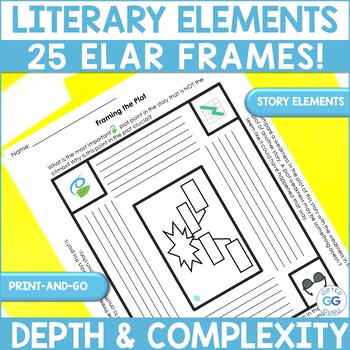Literary Elements Depth and Complexity Frames for Figurative Language ELA
- PDF
What educators are saying
Description
Teaching Literary Elements/Literary Devices or story elements? These Depth and Complexity Frames for English Language Arts will make your life so easy! You'll get 25 frames about reading and language arts ready to print and go! Yep, they're all done for you! Simply choose the topic you want students to explore, print and go! There are 25 frames done for you and ready to use right now to build student skills with analyzing using literary elements.
Two of the frames are teaching frames, meaning the direct instruction is built right in!
Depth and Complexity frames are a great way to focus student attention on a particular idea or concept. They're also perfect for alternative to a quiz or worksheet.
No need to be a Depth and Complexity expert. These frames are ready to use right away, no prep necessary. No, really.
The frames about story elements are designed to be used with any story, so you can use them over and over and over again. There's one for a specific story (The Secret Garden) so you can see what that might look like.
Included in this Depth and Complexity ELA Frames Resource:
✅ teacher instructions and ideas
✅ 25 ELA frames ready to print and go
✅ 22 different editable Depth and Complexity frames for you to make your own (along with directions for how to do so)
✅ Rubric to evaluate student work quickly
Language Arts and Reading Topics Covered:
✍ Author's style (3 different frames)
✍ Characterization (2 different frames)
✍ External Conflict
✍ Idioms
✍ Imagery (2 different frames)
✍ Irony
✍ Literary Devices
✍ Metaphor
✍ Narration
✍ Personification
✍ Plot
✍ Protagonist
✍ Setting (2 different frames)
✍ Simile
✍ The Secret Garden (A specific story!)
✍ Story Analysis (2 different frames)
✍ Theme (2 different frames)
✍ Tone and Mood
Frequently Asked Questions:
- Do I have to be a Depth and Complexity expert to use these? Not at all! Depth and Complexity frames can be used by people who are very, very new to the Depth and Complexity framework. In this resource, you'll find a link to find everything I've ever written about Depth and Complexity, so you'll be just fine.
- How ready to use are these Depth and Complexity ELA frames? Just print them and hand them out. It's that simple. If your students don't know the framework, just tell them to ignore the little pictures and answer the questions. The small images are in color, but you can print them in black and white, no problem.
- Can I leave these ready-to-use frames with a sub? Oh, yes! I'd suggest perhaps using one of the two that are teaching frames with the direct instruction built right in, but they would all be terrific as part of a sub plan.
Here's what teachers are saying about these Depth & Complexity ELA frames:
⭐⭐⭐⭐⭐
"The quotes are 100% appropriate, even from texts that are too mature for my students in their entirety. The students really got the most from having 4 different examples/quotes to really drive home the point of what author's style was. It created great conversation amongst the group, and students even learned a few new words from the quotes (never a bad thing!). This resource is FULL of great content, some pages are prompt heavy, some are quote heavy (so not monotonous)... This is a fantastic resource." — Kate C.
⭐⭐⭐⭐⭐
Um, print and go? Yes, please! I love the editable options for when I feel confident enough to make my own questions. This is an amazing, amazing resource that I will use for years to come. — Sarah C.
⭐⭐⭐⭐⭐
I've used this frames with my students as reading responses to novels we are reading in class. They are wonderful and really get the students thinking about the book at a deeper level. I love them! — Ann Z.
IF YOU LIKE DEPTH AND COMPLEXITY, YOU MAY ALSO WANT:
✨Depth and Complexity Digital Frames for use with Google Slides™/Classroom™
✨Depth and Complexity Ebook BUNDLE | Question Stems and Quick Guide
✨Depth and Complexity Fall Activity Bundle - Print and Go Fall Holiday Activities
Connect with me!
✨ Be sure to follow my TpT store by clicking on the red ‘Follow Me’ next to my Seller picture to receive notifications of new products and upcoming sales.
✨ Come on over to Facebook or Instagram and join in the Gifted Guru ideas and tips fun!





